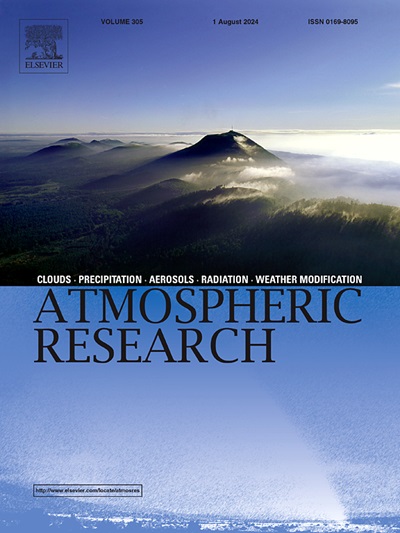Convective cold pools and attendant turbulence at the Amazon Tall Tower Observatory (ATTO)
IF 4.4
2区 地球科学
Q1 METEOROLOGY & ATMOSPHERIC SCIENCES
引用次数: 0
Abstract
Deep moist convection significantly disturbs the evolution of the planetary boundary layer (PBL) through its convective cold pools (CCPs). This study investigates the statistics of CCPs and their impact on PBL turbulence as observed at the Amazon Tall Tower Observatory (ATTO) site. To obtain a large dataset of CCPs, we adapted an existing CCP-detection algorithm for use in multilevel, micrometeorological data. Application of the algorithm to ATTO observations collected from August 2021 through December 2023 resulted in a dataset consisting of 410 CCPs. CCPs occur nearly every other day at the ATTO site, although they are most common from April through September and are least common from December through March. The occurrence of CCPs is linked to the diurnal cycle of the PBL, with more events around 1800 UTC and the less events around 1100 UTC. The strength of CCP perturbations varies strongly as a function of the distance from the canopy. Above the canopy (approximately 37 m), CCPs exhibit well-defined gust fronts, marked by sharp drops in temperature and humidity, gusting winds, overturning circulations, and pressure rises. During gust front passages, sensible (latent) heat fluxes are briefly enhanced and subsequently invert sign (weaken) in the CCPs, as previously unstable (moister) PBLs become stable (drier). Turbulence is stronger and more anisotropic during gust fronts and just above the canopy due to mechanical drag. Anisotropic turbulence may be transported upward to 200 m by the gust fronts. Below the canopy, CCPs and attendant perturbations are drastically damped, except in high-end cases.
亚马逊高塔天文台(ATTO)的对流冷池和伴随的湍流
深层湿对流通过对流冷池(CCPs)显著干扰了行星边界层(PBL)的演化。本文研究了亚马逊高塔天文台(ATTO)站点观测到的ccp的统计数据及其对PBL湍流的影响。为了获得大型ccp数据集,我们采用了现有的ccp检测算法,用于多级微气象数据。将该算法应用于2021年8月至2023年12月收集的ATTO观测数据,得到了由410个ccp组成的数据集。在ATTO站点,ccp几乎每隔一天发生一次,尽管它们在4月至9月最常见,在12月至3月最不常见。ccp的发生与PBL的日循环有关,在1800 UTC附近发生的事件较多,而在1100 UTC附近发生的事件较少。CCP扰动的强度随离树冠距离的变化而变化。在冠层上方(约37米),ccp表现出明确的阵风锋,其特征是温度和湿度急剧下降、阵风、翻转环流和压力上升。在阵风锋通道期间,感热(潜热)通量短暂增强,随后在ccp中反转(减弱),因为先前不稳定(较潮湿)的pbl变得稳定(较干燥)。在阵风锋期间,由于机械阻力的作用,湍流更强,各向异性更强。各向异性湍流可由阵风锋向上输送至200米。在冠层以下,ccp和伴随的扰动被剧烈地阻尼,高端情况除外。
本文章由计算机程序翻译,如有差异,请以英文原文为准。
求助全文
约1分钟内获得全文
求助全文
来源期刊

Atmospheric Research
地学-气象与大气科学
CiteScore
9.40
自引率
10.90%
发文量
460
审稿时长
47 days
期刊介绍:
The journal publishes scientific papers (research papers, review articles, letters and notes) dealing with the part of the atmosphere where meteorological events occur. Attention is given to all processes extending from the earth surface to the tropopause, but special emphasis continues to be devoted to the physics of clouds, mesoscale meteorology and air pollution, i.e. atmospheric aerosols; microphysical processes; cloud dynamics and thermodynamics; numerical simulation, climatology, climate change and weather modification.
 求助内容:
求助内容: 应助结果提醒方式:
应助结果提醒方式:


